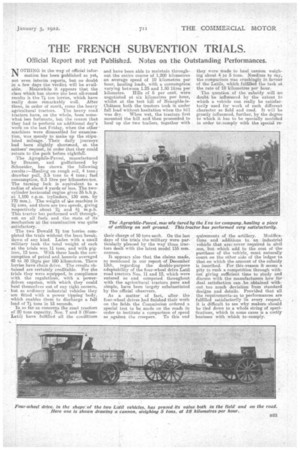THE FRENCH SUBVENTION TRIALS.
Page 23

If you've noticed an error in this article please click here to report it so we can fix it.
Official Report not yet Published. Notes on the Outstanding Performances.
N°THING in the way of official information has been published as yet, not even interim reports, but no doubt in a few days the verdict, will be avail
able. Meanwhile it appears that the class which has shown the best. all-round results is the 4 ton lorries, which have really done remarkably well. After these, in order of merit, come the heavy agricultural tractors. The heavy road tractors have, On the whole, been somewhat less fortunate, but the reason that they had to perform an additional day's work on the last Friday, when the other ' machines were dismantled for examination, was merely to make up the stipulated mileage. Their daily journeys had been slightly shortened, at the makers' request, in order that they could return to the park before nightfall. .
The Agrophile-Pavesi, manufactured by Brasier, and godfathered by SChneider, has shown the following results :—Hauling on rough soil, 4 tons; drawbar pull, 3.5 tons to 4 tons ; fuel consumption, 0.3 litre per kilometre-ton. The turning lock is equivalent to a radius of about 4 yards or less. The twocylinder horizontal engine gives 35 b.h.p. at 1,190 r.p.m. (cylinders, 130 mm. by 170 min.). The weight of the machine is 4 tons, and there are two speeds, giving respectively about 2,k and 4.1m.p.h. This tractor has performed well through-, out on all fuels and the. state of its mechanism at the examination was quite satisfactory.
The two Dewald 7k ton lorries completed the trials without the least breakdown of any kind. Laden with a small military tank the total weight of each at the trials was 11 tons, and with pigiron, 12 tons. With these loads the consumption of petrol and benzoic averaged 45 to 50 litres per 100 kilometres. These lorries have chain drive. The results obtained are certainly creditable. For the trials they were equipped, in compliance with the regulations, with a powerdriven capstan, with which they could haul themselves out of any tight corners, but as ordinary industrial vehicles they are fitted with a power tippingbody,
• which enables them to discharge a full load of 7k tons in 15 seconds. In so far as concerns the road tractors of 20 tons capacity, Nos. 7 and 8 (BlumLatil) have fulfilled all the conditions and have been able to maintain throughout the entire course of 1,200 kilometres an average speed of 10 kilometres per hour, hauling loads, with a consumption varying between 1.25 and 1.50 litres per
kilometre. Hills of 6 per cent, were negotiated at six kilometres per hour, whilst at the test hill of Neauphle-leChateau both the tractors took it under full load without hesitation when the bill was dry. When wet, the tractors first mounted the hill andthen proceeded to haul up the two trailers, together with
their charge of 10 tons each. On the last days of the trials the -military were particularly pleased by the way these tractors dealt with the latest model 155 ram. cannon.
It appears also that the claims made, as mentoned in our report of December 13th, regarding the double-purpose adaptability of the four-wheel drive Latil road tractors Nos. 11 and 12, which were entered as and competed throughout with the agricultural -tractors pure and simple, have been largely substantiated by the official observers.
As a matter of fact, after the four-wheel drives had finished their work on the fields the Commission ordered a special test to be made on the roads in order to institutea comparison of speed as .against the creepers. To this end
they were made to haul cannon weighing about 4 to 5 tons. Needless to say, the comparison was crushingly in favour of the Laths, hich fulfilled the task at the rate of 18 kilometres per hour.
The question of the subsidy will no doubt be influenced by the extent to which a vehicle can really be 'satisfactorily used for work of such different character as field and road. It will be greatly influenced, further, by the degree to which it has to be specially modified in order to:comply with the special re qnirements of the artillery. Modifica
tions and additions to an industrial vehicle that are never required in civil use, but which add to the cost of the purchase of the vehicle, must naturally count on the other side of the ledger to that on which the amount of the subsidy is inscribed. For,this,reason it seems a pity to rush a competition through without giving sufficient time to study and discuss with the manufacturers how far dual satisfaction can .be obtained without too much deviation from standard designs and details. Provided that all the requirements:as to performances are fulfilled satisfactorily in every respect, it is difficult to see why makers should be tied down to a whole string of specifications, which in some cases is a costly business with which to-comply:




























